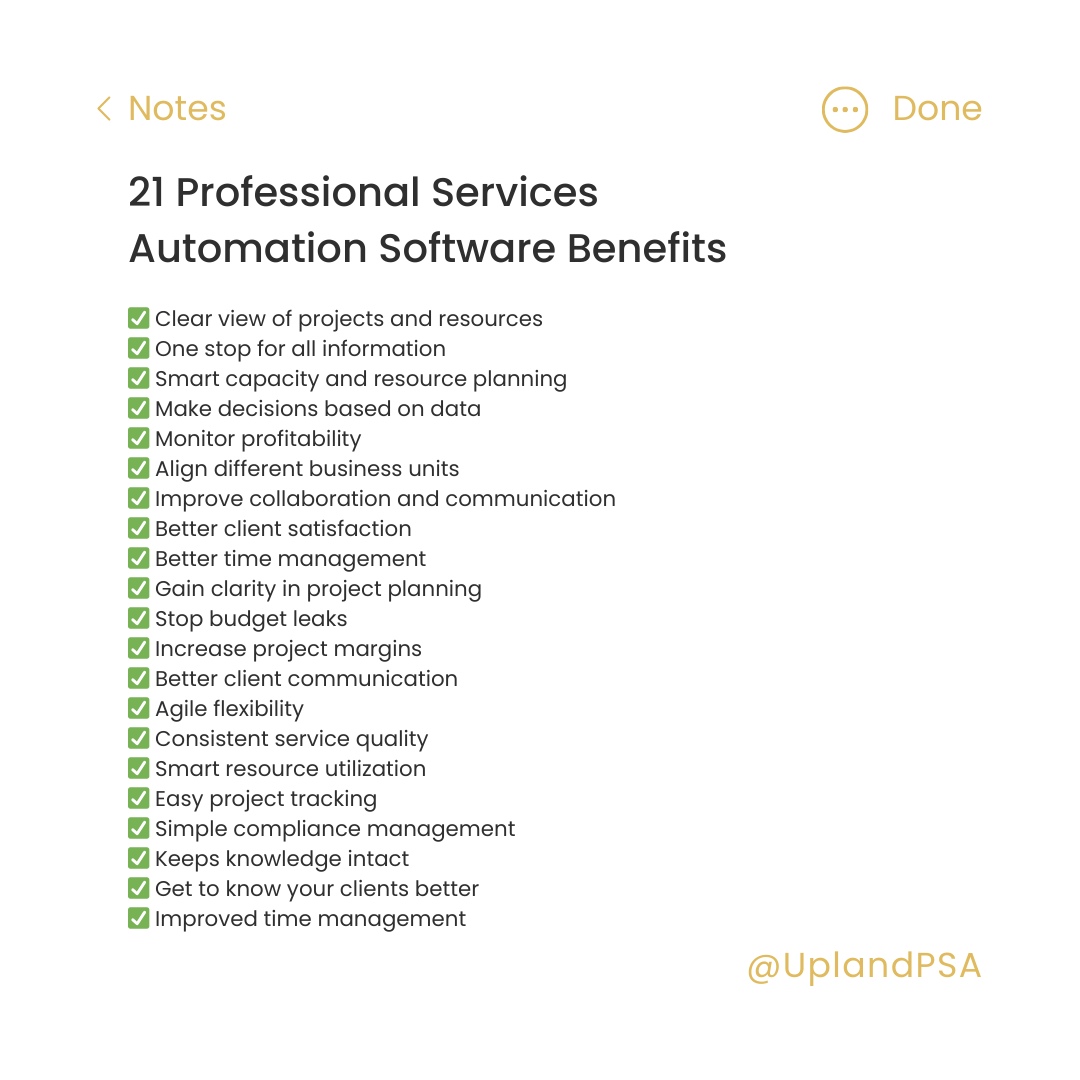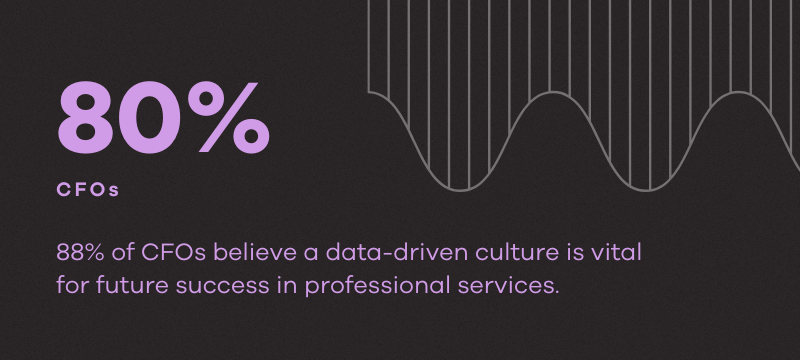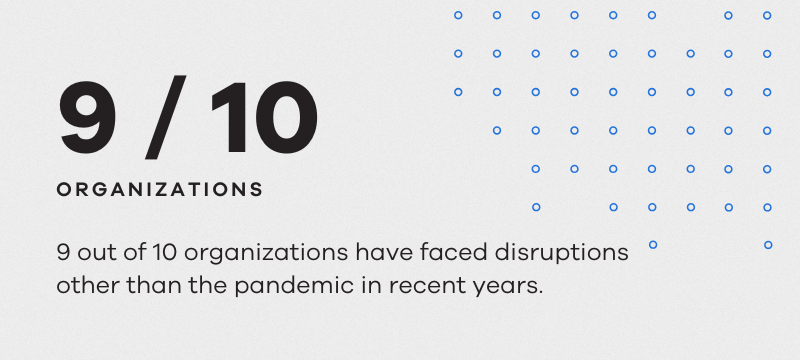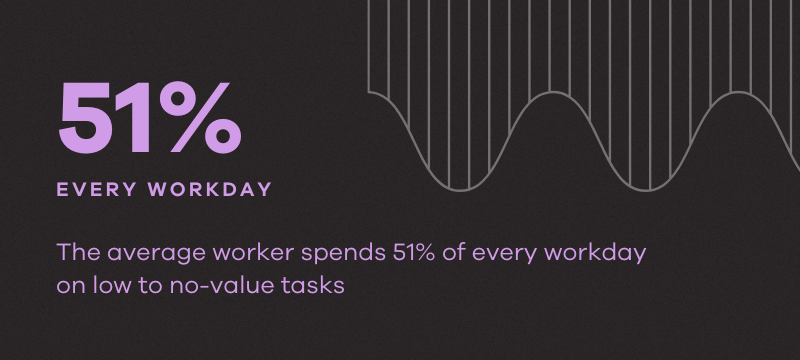Professional services automation software has come a long way, yet many professional service firms still struggle to make the most of it. Salesforce found that about 45% still manage leads and opportunities manually. Far too many firms struggle with outdated processes and juggling multiple tasks, and they’re getting left behind. And this gap is only widening as agile competitors rely on technology to improve service delivery. That’s why we’re exploring some professional services automation software benefits in 2025.
These challenges will only become more challenging as client expectations rise. While some still cling to traditional methods, the best firms are advancing with professional services automation software.

What is Professional Services Automation Software?
Professional services automation software simplifies operations for professional services firms. It combines project management, resource planning, and financial tracking into one platform. This integration streamlines workflows and improves service delivery, creating better outcomes for clients.
With PSA software, organizations can automate routine tasks and get real-time insights. These insights help teams make more intelligent decisions quickly. In the end, PSA software supports business growth and increases profitability.
What is the History of Professional Services Automation?
Professional services automation dates back to the 1990s, when the term was coined. Its history tells a story of innovation. What started with basic project and customer relationship management tools has grown into powerful platforms that integrate various business functions.
- PSA emerged to meet the demand for efficient financial management and project accounting. It aimed to simplify invoicing and help financial departments monitor performance.
- Things took a turn in 1997 when a Silicon Valley company introduced the PSA concept to the Aberdeen Group. Hofferberth explored its potential and found many small vendors already offering similar solutions.
- The first PSA white paper resulted from Hofferberth’s research. It generated significant interest from companies worldwide and confirmed the industry’s potential.
- In 1998, Farzad Dibachi, founder of Niku Corp., introduced his project management software designed for professional services automation. To gain traction, he contacted IT research firms, including Gartner and Forrester Research, to write about his product.
- R. David Hofferberth from Aberdeen Group responded to Dibachi’s pitch, producing a white paper that articulated PSA as a new class of enterprise software, establishing an organizing vision for the category.
- Analysts like Hofferberth help define emerging markets by interpreting trends and creating a broader understanding of innovations like PSA, establishing themselves as thought leaders.
- Upland has played a key role since 1995 by creating innovative PSA solutions, starting with a timesheet automation tool. It has since expanded its offerings to include resource management, project management, and automated billing.
PSA software is always shifting. Upland PSA, in particular, has been on quite a journey in recent years. And as it grows, it stays focused on providing solutions that match your goals.
Who Uses PSA Software?
PSA software is used worldwide by a range of professional services organizations. While it’s a helpful tool used by professionals in various roles, here are some of the key users of PSA software:
- Sales Teams and Solution Architects
- Resource Managers
- Project Managers
- Delivery Managers
- Finance Teams
- Executives
- Marketing Teams
- Human Resources Teams
Every role has advantages. Sales teams and solution architects rely on it for project planning and scoping, and resource managers ensure the right people are matched with the right tasks.
Project and delivery managers keep an eye on progress and make sure projects stay within budget. Finance teams focus on accurate revenue recognition, while executives rely on dashboards for insights into business and key performance indicators. Marketing and HR teams tap into PSA software to align resources and manage staff needs.
Remember, this list isn’t all-inclusive. PSA software can support a range of teams. In SPI Research’s Professional Services Benchmark Survey, Dave Hofferberth suggests that firms should consider using a PSA tool once they reach 20 employees. On top of that, if your firm is billable, project-based, and people-focused, PSA software could be the right solution for you.
Professional Services Automation Benefits
PSA software is gaining traction. Statista reports that revenue is expected to grow at an annual rate of 5.62%, reaching a market volume of USD 95.44 billion by 2029. There is good reason for this, too. There are a range of benefits to professional services automation.

1. Clear View of Projects and Resources
Many organizations need more visibility into their projects and resources. According to Forrester Consulting research, 58% complain of a lack of visibility into their plan versus actual project performance.
Project managers risk missing budget overruns without real-time insights. Like Upland PSA, PSA software provides a clear view of the service delivery cycle. This visibility helps teams monitor projects closely and catch budget issues early on. When problems crop up, project managers can take action before it’s too late.
2. One Stop for All Information
As PwC points out, workers and CEOs agree about workplace inefficiencies. They estimate that roughly 40% of their time spent on administrative tasks is wasted, which shows a clear need for better business processes.
When team members waste time tracking project documents or emails, they create unnecessary stress. Upland PSA handles this issue by storing all essential project information under one roof.
It ensures that everyone can easily access the latest updates. This centralization improves workflows and reduces errors, helping teams work smarter.
3. Smart Capacity and Resource Planning
Finding the right people for the right tasks can be challenging in professional services. Unfortunately, inadequate forecasting is the most significant barrier to effective enterprise resource planning and management in the industry. RMI found that it contributes to 88% of the problem.
Resource managers often struggle to understand staff skills and availability. Professional services automation solutions like Upland PSA help organizations gain visibility into their workforce, which allows for more thoughtful resource planning.
Managers can quickly see who’s available and what skills they bring. This way, they can match the right people with the right tasks. The result is more balanced workloads, less employee burnout, and better project delivery.
4. Make Decisions Based on Data
You need the right data at your fingertips in professional services. Teams struggle without it. They lose their way and can’t make wise decisions. 56% of organizations lack the data or insights needed for solid forecasting. That’s a difficult spot to be in.
Data brings real benefits. Research by BARC tells us that businesses using big data can boost profits by 8% and cut costs by 10%. It’s not just about the numbers, too. A recent Bloomberg report found that 88% of CFOs believe a data-driven culture is vital for future success.

Upland PSA connects you with the data you need. It centralizes project information and gives teams real-time access to critical data, making it easy to analyze metrics, track progress, and forecast resource needs.
5. Monitor Profitability
Maintaining profitability can be a constant challenge in professional services. Organizations often struggle to keep projects within budget and maximize billable hours. However, those who use professional services automation software tend to fare better. For example, SPI Research achieved an employee billable resource utilization rate of 70.9%, while those without a PSA solution only reached 68.3%.
Upland PSA tracks costs and expenses against the budget in real time, helping teams monitor spending. This oversight of expense management allows organizations to guard their profit margins and make adjustments before issues escalate.
6. Align Different Business Units
When departments in professional services aren’t on the same page, chaos often follows. Essential project details can slip through the cracks, leading to costly mistakes. For example, overspending can happen if the project management and finance teams aren’t on the same page about budget updates.
Upland PSA connects key business processes and functions. It keeps communication smooth and data flowing. This integration helps teams collaborate better, improves project execution, and reduces mistakes.
7. Improve Collaboration and Communication
Working in siloes will only get you so far in professional services. Cross-functional work comes with a range of benefits. It opens the door to knowledge sharing and helps you deliver better client outcomes.
PwC found that 61% of companies say that better collaboration across functions and faster decision-making are essential to reaching their strategic goals. Stanford found that teams that work together can focus on tasks for 64% longer than those who work alone. When everyone’s on the same page, projects move forward.
Professional services automation like Upland PSA makes this possible. It encourages real-time collaboration and boosts productivity as a central hub for project conversations. Your team can easily tap into the project life cycle from one platform.
8. Better Client Satisfaction
It’s a challenge to keep clients in the know. They’re curious about how their projects are progressing, and their expectations are climbing.
One survey shows that 51% of clients want higher-quality work, 50% expect quicker service delivery, and 48% want better cost transparency. Organizations need the right tools to keep up with these growing demands.

Professional services automation helps keep the lines of communication open with clients. Upland PSA, for example, allows firms to give regular updates and easy access to project status. It helps bridge the gap between client expectations and what they receive.
9. Better Time Management
Professional services aren’t immune to busy work. It finds its way into our days, pulling us away from the high-value tasks that drive profits. Manual data entry and repetitive processes waste our time and energy, taking away billable hours that could be better spent on client work.
PwC revealed that CEOs find about 40% of their time spent on meetings, admin tasks, and emails inefficient. They also note that 35% of time spent in decision-making meetings isn’t productive, even when they control it.
Upland PSA‘s professional services automation tools simplify these routine tasks, freeing team members to focus on high-impact work instead. Less administrative work means more time for what matters.
10. Gain Clarity in Project Planning
There’s often uncertainty about what lies ahead in professional services. That’s why predicting project timelines and your needed resources can be difficult. The industry as a whole is always in flux, and client expectations are never static. As a result, project planning can be challenging.
Professional services automation like Upland PSA helps improve predictability by analyzing resource availability and past performance. This insight allows teams to plan more effectively and make smart choices about hiring and resource allocation. It cuts down on uncertainty and builds confidence in project planning.
11. Stop Budget Leaks
Budget leaks can cut into profits and create financial stress in professional services. Yet many organizations still struggle to monitor their financial reporting and spending. That’s why McKinsey found that projects typically overrun their budgets and schedules by 30% to 45%.

Upland PSA helps by tracking planned versus actual spending. It makes it easier for teams to spot areas of overspending and take corrective action before financial issues spiral out of control. This helps them protect their financial health and keep their bottom line strong.
12. Increase Project Margins
It’s unclear which projects or clients are the most profitable in professional services. As a result, many organizations find it challenging to see their profitability.
A Workday study found that employee billable resource utilization and project margins have dropped below five-year averages. This trend points to the need for better resource management to increase profit margins.
Upland PSA provides teams with clear insights into each project’s revenue, costs, and profit margins. As a result, they can make smarter decisions about future projects and how to allocate resources effectively.
13. Better Client Communication
Clients today expect transparency and clear communication. They want to know how their projects are progressing at every step. Keeping clients updated can struggle when organizations lack the right professional services and automation tools.
This is an issue. PwC outlined that 59% of customers will leave after several bad experiences. Even more surprising, 32% would stop doing business with a brand they love after just one negative encounter.
Upland PSA meets this challenge head-on by giving clients access to real-time project statuses. Clients can see where things stand anytime they want. This round-the-clock visibility allows organizations to manage client expectations more effectively.
14. Agile Flexibility
The professional services industry never stands still. New client demands, and market conditions can crop up out of nowhere. PwC and Workday learned that 9 out of 10 organizations have faced disruptions other than the pandemic in recent years.

This makes it clear that disruption is here to stay. And organizations often struggle to adapt to these changes quickly, which can throw project timelines and quality off track.
Upland PSA helps teams stay nimble. It allows them to adjust project scopes and resources on the go. Firms can respond to changes with flexible, professional services automation tools without missing a beat.
This adaptability keeps them competitive and ready to meet client needs. By leveraging these tools, organizations can navigate ongoing disruptions and thrive in a dynamic environment.
15. Consistent Service Quality
Delivering consistent service quality across various projects can be a challenge. Without standardized processes in place, variations in execution can occur. This inconsistency can lead to client dissatisfaction.
Upland PSA promotes best practices by offering templates and guidelines for project management. By standardizing processes, teams can ensure they consistently deliver high-quality results. This approach builds trust with clients and enhances the organization’s reputation.
16. Smart Resource Utilization
Organizations often have talented employees but don’t fully tap into their skills. In professional services, where attrition rates are typically higher than in other industries, it’s crucial to engage the talent you have.
According to Statista, the employee attrition rate in these organizations rose from 2013 to 2023, reaching an average of 12.5% in 2023. This trend highlights the need for organizations to focus on keeping skilled workers around.
Talented individuals can find themselves stuck doing tasks that don’t fit their strengths when visibility into resource allocation is lacking. This underutilization can lead to frustration and low morale, which might drive people to leave.
Upland PSA helps organizations identify skills gaps and areas of underutilization. Managers can quickly see who has the right skills for specific projects. By reshuffling tasks, organizations can ramp up performance and keep employees engaged. Tackling these issues boosts morale and helps retain valuable talent, reducing the risk of further attrition.
17. Easy Project Tracking
Tracking multiple projects simultaneously can quickly become complex. Different teams may handle various aspects, making it hard to see the big picture. Upland PSA simplifies this process by consolidating all project lifecycle data into one platform.
Managers can quickly assess project statuses and get a clear view of progress. This clarity enables them to intervene when necessary, keeping everything on track. With Upland PSA, teams can work more efficiently and stay aligned with project goals.
18. Simple Compliance Management
Compliance with industry regulations is crucial for any organization but can feel like a heavy lift. Keeping track of compliance without the right systems in place can be overwhelming. A survey by PwC found that 75% of organizations struggle to keep up with the fast pace of regulatory changes.

Upland PSA helps by offering tools that monitor adherence to standards and regulations. This functionality ensures projects meet necessary guidelines and cuts down the risk of costly compliance issues. By streamlining compliance management, organizations can put their energy into delivering real value to their clients.
19. Keeps Knowledge Intact
When employees leave, organizations lose valuable institutional knowledge, harming project continuity and overall performance.
American workers waste about 5.3 hours each week searching for information or recreating what’s already out there. That’s a clear indication of the importance of effective knowledge management.
Upland PSA helps solve this problem by centralizing knowledge sharing and documentation. Teams can easily capture lessons learned and best practices in one spot.
This centralization helps organizations retain critical information, even when staff changes occur. By keeping institutional knowledge intact, organizations can stay consistent and keep the wheels turning.
20. Get to Know Your Clients Better
Many organizations struggle to understand client behaviors and preferences. It’s challenging to know what clients truly value. Fortunately, analytics fills in the gaps.
A McKinsey survey shows that companies that effectively use customer analytics are 23 times more likely to attract new customers, six times better at retaining customers, and 19 times more likely to increase profitability.
PSA software provides analytics to track client trends and interactions. It helps teams identify patterns in client preferences. Upland PSA offers detailed insights that help organizations tailor their services.
Teams can use these insights to adapt their approach to deliver projects that meet client expectations head-on. This effort strengthens client connections and encourages repeat business, which is essential for long-term success.
21. Improved Time Management
Time management and expense tracking are balancing acts in professional services. This is especially true if you get caught up in manual tracking, which inevitably leads to mistakes and lost revenue.
As noted in Inc., the average worker spends 51% of every workday on low to no-value tasks, making it even harder to focus on high-impact work. Project outcomes and timelines can suffer when teams struggle to allocate resources effectively.

PSA software automates time tracking, making it easier to capture billable hours accurately. It reduces the administrative burden, which allows team members to focus on their core responsibilities.
Upland PSA simplifies this process with user-friendly features that integrate into everyday workflows. Teams can optimize resource allocation and boost overall productivity, ensuring they make the most of every billable hour.
Upland PSA: Your Team’s PSA Solution
Before you choose a PSA system, gather your stakeholders and discuss a few important questions. What are your goals? How do you want the PSA tool to help you achieve them? Make a list of must-have features and some nice-to-haves.
Next, consider your budget. How much are you willing to spend? Consider who will use the software and what training they might need. If your organization has multiple offices, you may need different setups for each location. Finally, check if there are any existing systems you want to integrate with the new PSA.
Once you’ve answered these questions, Upland PSA could fit your needs well. Its robust features and user-friendly interface simplify workflows and improve team collaboration. Make a change with Upland PSA.
